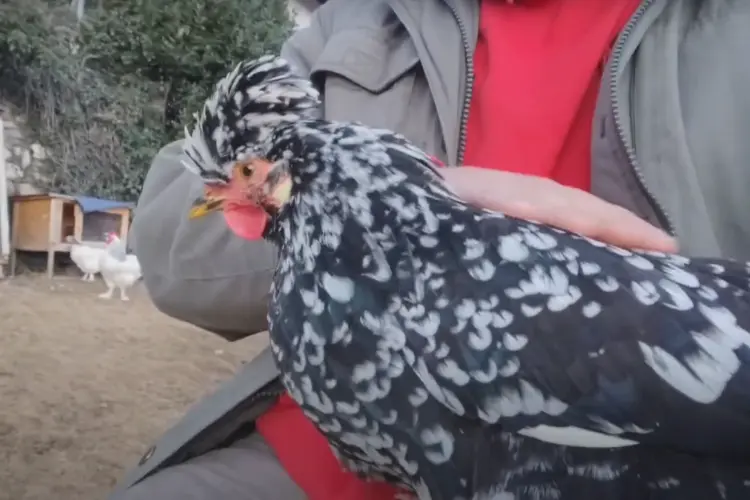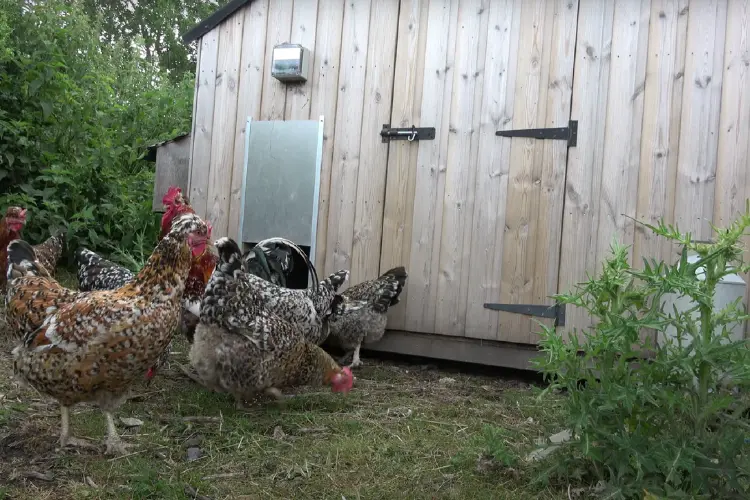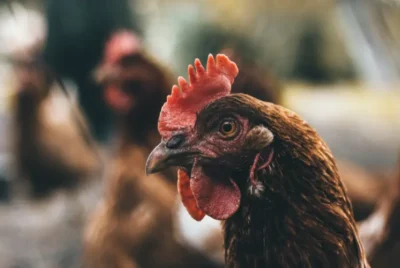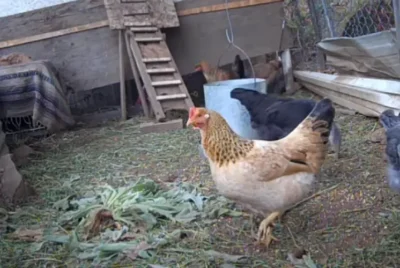Breed Profile of The Swedish Flower Hen
Have you ever heard of a chicken breed so diverse and beautiful that it stands out from the flock? Meet the Swedish Flower Hen, a breed that not only boasts a striking appearance but also an adaptable and friendly temperament. Journey with me as I explore this fascinating breed and learn how to care for and appreciate these unique birds.
Swedish Flower Hen Overview
- Beginner Friendly: Yes
- Lifespan: 5-10 years
- Weight: Hen (5lb) and Rooster (8lb)
- Color: Black, blue, red, orange and brown
- Egg Production: 3-4 per week
- Egg Color: Brown
- Known For Broodiness: No
- Good With Children: Yes

The Origins of the Swedish Flower Hen
The Swedish Flower Hen is a landrace breed that developed naturally in Sweden and nearly went extinct, but was fortunately preserved by the efforts of dedicated enthusiasts. These chickens native to Southern Sweden boast a considerable amount of genetic diversity, making each hen in a flock exhibit a unique physical appearance.
This diversity makes them an interesting and attractive choice for a pet chicken. Although there is no breed standard recognized by the American Poultry Association, their adaptability and hardy traits make them a popular choice among chicken enthusiasts.
Landrace Development
Swedish Flower Hens are a landrace breed, meaning they developed naturally without human intervention, resulting in a diverse genetic makeup. Over hundreds of years, these landrace birds adapted to the local conditions and husbandry systems in Southern Sweden, leading to their varied genetic composition.
Their landrace status accounts for the variance in appearance, presenting a broad spectrum and free range of colors and patterns that distinguishes them from other breeds.
Near Extinction and Preservation Efforts
The turn to commercialization in Sweden’s poultry industry almost pushed the Swedish Flower Hen to extinction, as their population shrank significantly by the 1970s.
Thankfully, dedicated enthusiasts formed the Svenska Lanthönsklubben in 1986, discovering decades ago remnant flocks and initiating efforts to preserve the breed. The Svenska Lanthönsklubben established the Gene Bank to uphold the breed’s diversity, increase its population, ensuring its survival as a heritage breed.
Appearance of Swedish Flower Hen
Color Patterns and Varieties
Presenting in multiple shades of black, blue, red, brown, and buff, the feathers of the Swedish Flower Hen are tipped with white, forming a millefleur (thousand flowers) feather pattern.
One of the rarest coloration patterns is the Snow Leopard variety, characterized by black tips replacing the white ones, resulting in an overall gold/white/black motif.
Their varied appearance is a testament to the breed’s diverse genetic background. This vibrant assortment of colors and patterns ensures that no two Swedish Flower Hens are identical.
Crested and Tasseled Birds
Some Swedish Flower Hens have crests or tassels on their heads, further enhancing their distinctiveness and charm. While not all birds within the same breeders will possess these unique head adornments, those that do are a delightful sight to behold.
Crested birds have a noticeable crest of feathers on their head, while tasseled birds feature tassels or tufts of feathers on their head. The genetics that control crests and tassels may be disparate, but both contribute to the enchanting appearance this breed.

Temperament and Behavior of Swedish Flower Hen
Their calm and independent nature renders Swedish Flower Hens a perfect choice for families and novice chicken keepers. Their self-sufficient and adaptable demeanor allows them to thrive in various environments, while their friendly nature endears them to humans and other animals.
Calm and Independent Nature
The Swedish Flower Hen is renowned for its tranquil and autonomous disposition, making them a delight to interact with. They are commonly perceived as:
- Amicable
- Compassionate
- Assured in the presence of humans
- Enjoying human attention and free-ranging exploration.
Their curiosity towards their environment makes them an engaging, curious and entertaining breed to observe and interact with.
Compatibility with Other Animals
These chickens exhibit a greater degree of tolerance for the presence of other animals than that of most avian species. Their non-aggressive nature makes them an excellent addition to a mixed-species flock or a family with pets.
By providing a secure environment with ample room for all animals to move freely, Swedish Flower Hens and other chickens can live happily alongside other animals.

Noise Levels
These chickens are relatively communicative and are more suitable for rural areas where they can be more expressive. They are known to be chatty and expressive, though not particularly loud.
Their melodious clucking can be a source of delight for those who appreciate the simple joys of backyard chicken keeping.
Read also: Breed Profile of The Golden Sex Link Chicken
Care and Maintenance of Swedish Flower Hen
Feeding Requirements
To sustain their overall health and well-being, Swedish Flower Hens require nutrient-rich, high-quality feed. As chicks, their feed should be higher in protein to support their growth and development. When they reach adulthood and begin to lay eggs, they may benefit from additional calcium in their diets to ensure strong eggshells.
Allowing your Swedish Flower Hens to forage for insects and vegetation can also improve their health and well-being, as it allows them to search for additional nutrients and can assist in eliminating pests from your garden.
Housing and Space Needs
To ensure their contentment and vitality, they need ample space. I suggest furnishing at least two to four square feet of space per bird within the coop and at least 8 square feet of run space per bird. They do not tolerate confinement adequately, thus it is essential to give them substantial room to move around.
Ensuring the enclosure is secure from predators is necessary to provide a safe environment for your chickens to thrive.

Weather Tolerance and Health Concerns
With their high cold tolerance, they can withstand temperatures as low as -20°C. Their dense protective feathers provide insulation and warmth during colder months, making them an ideal choice for those living in cooler climates.
However, in warm climates, I suggest providing ample shade and access to a refreshing water supply to ensure their comfort.
In general, Swedish Flower Hens are a healthy and hardy breed, with no significant health issues to be aware of. However, as with any breed, it is always important to monitor your birds for signs of illness or parasites.
Read also: All You Need to Know About Dixie Rainbow Chicken Breed
Egg Production and Fertility
Proving to be good egg layers, Swedish Flower Hens generate 150-200 eggs annually, with roosters contributing to fertility.
Egg Size and Color
The eggs produced by Swedish Flower Hens are a delightful pale brown in color. When the hens first start laying, the eggs are small in size but as the hen continues to lay, the size of the eggs increases.
Over time, they typically lay large to extra-large eggs, providing a plentiful supply for you and your family to enjoy. This unique egg color and size make these hens an attractive and productive addition to any backyard chicken flock.
The Role of Roosters in Fertility

While a rooster is not necessary for egg production, it does play a crucial role in fertility, ensuring the fertilization of eggs and the development of embryos. Incorporating a rooster into your flock can facilitate the fertilization of eggs and the maintenance of genetic diversity, allowing you to breed your Swedish Flower Hens and expand your flock naturally.
However, it is also important to remember that roosters can be loud and domineering, so consider your environment and the compatibility of your flock when deciding whether to include a rooster.
When Do Swedish Flower Hens Start Laying?
Swedish Flower Hens typically commence laying eggs when they reach an age of 5 to 6 months, which is when these hens lay their first eggs. Initially, the eggs are diminutive in size, yet they increase as time progresses.
Conclusion
The Swedish Flower Hen is a unique and diverse breed of chicken that boasts a beautiful appearance, friendly temperament, and adaptability to various climates. Whether you are an experienced chicken keeper or a newcomer to backyard poultry, these hens are an enchanting and engaging addition to any flock.




